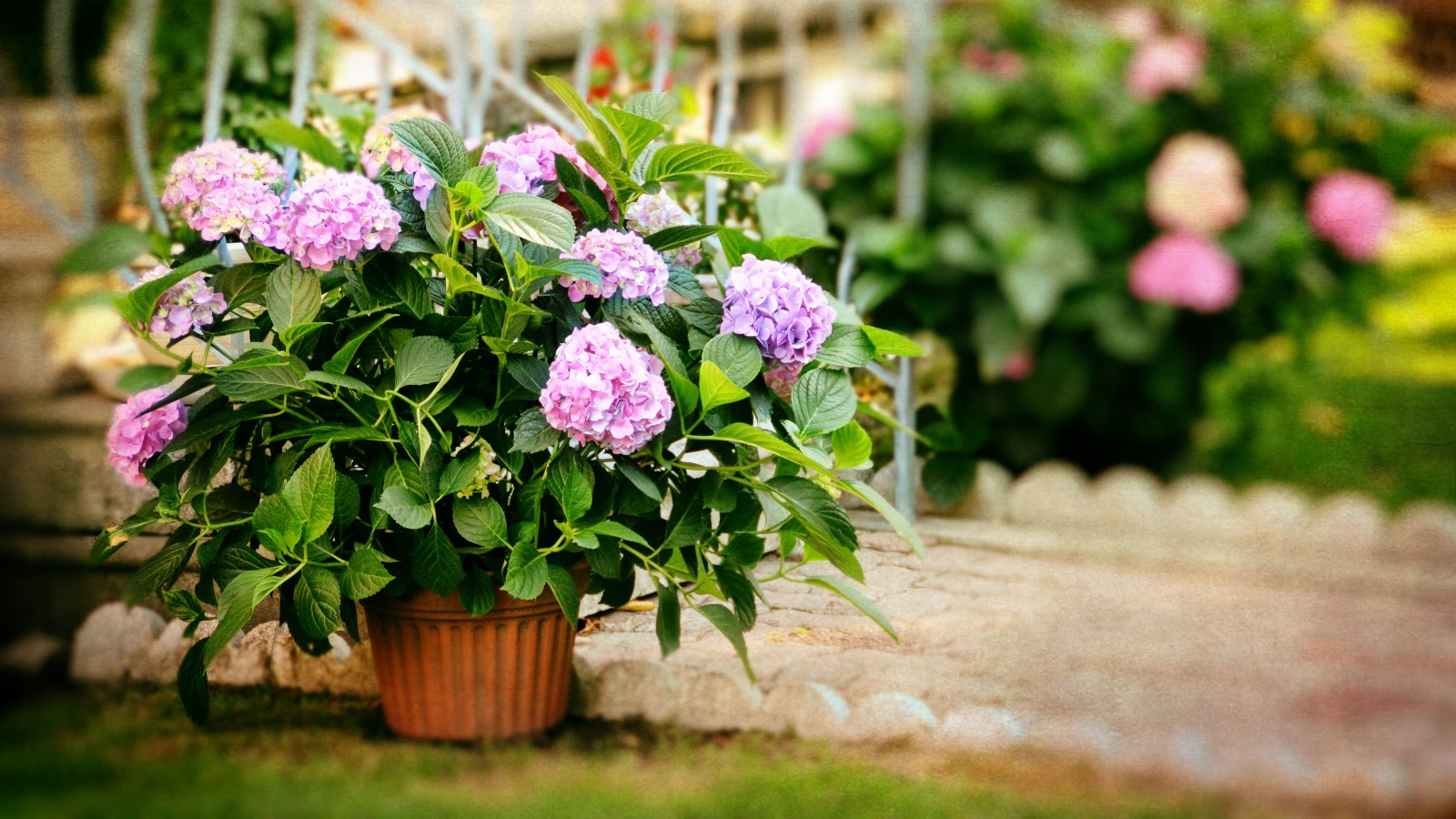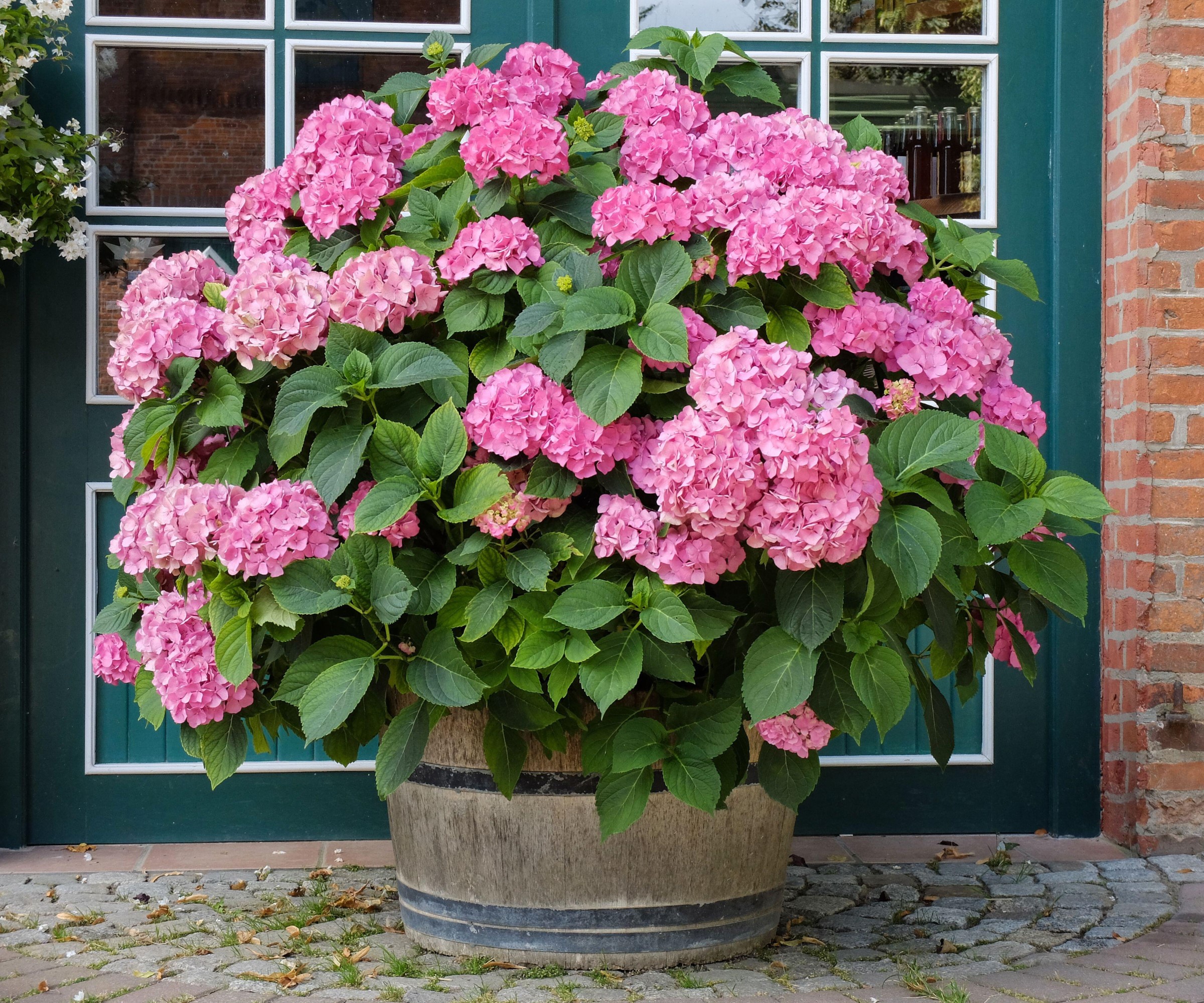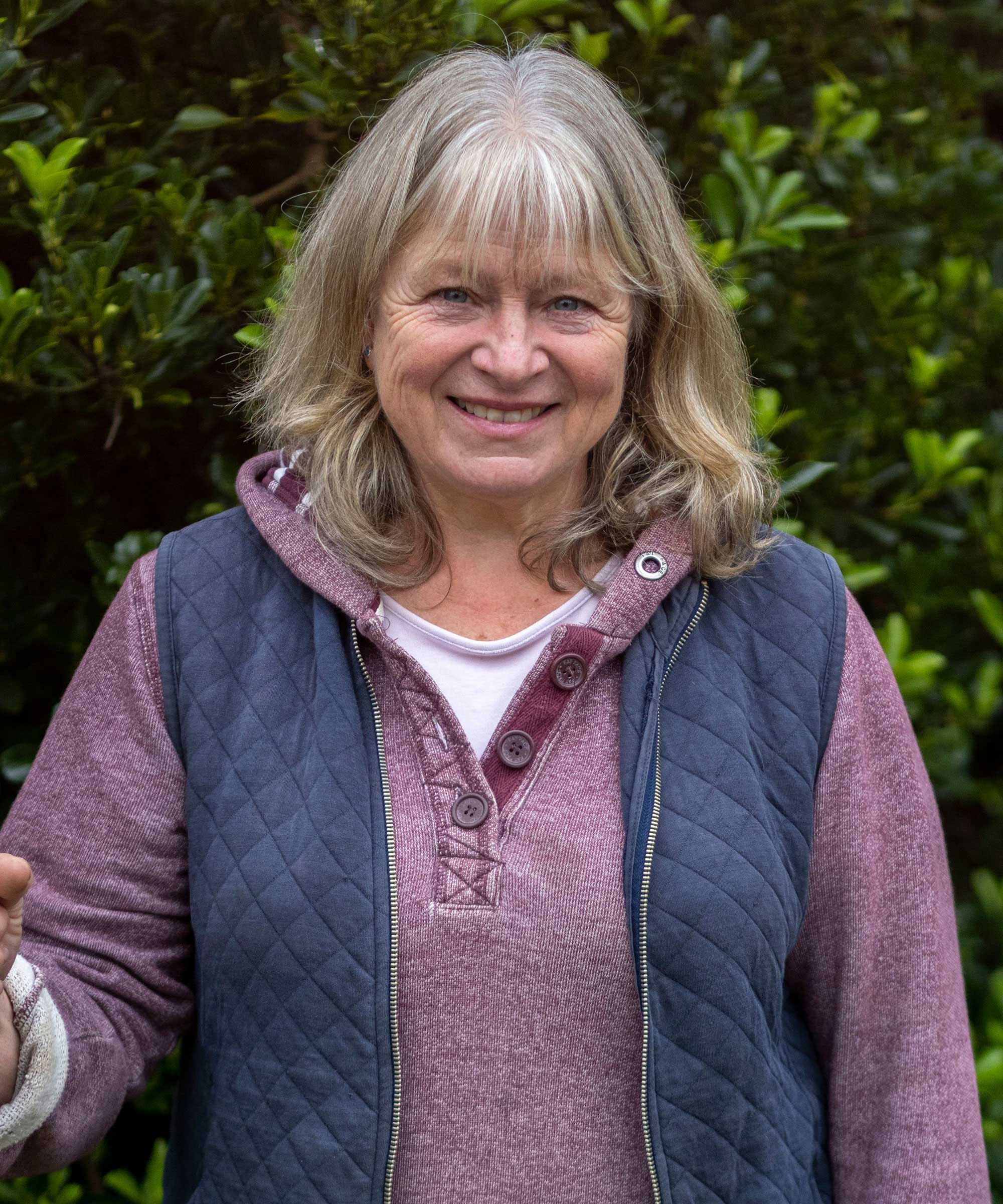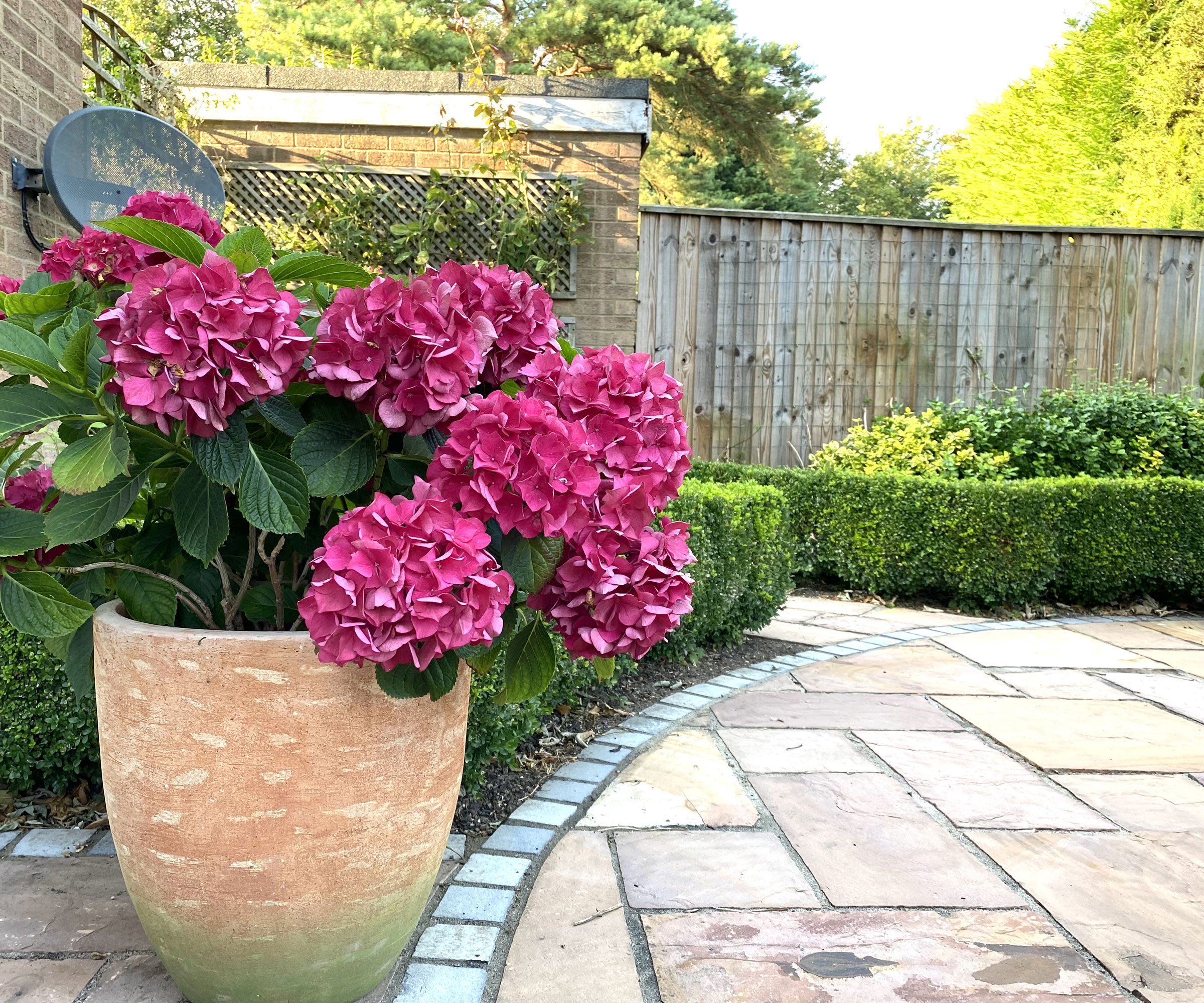How to grow hydrangeas in pots – expert tips to guarantee your shrubs flourish
Compact hydrangeas can put on a show of blooms in containers in a shady spot in your yard


Hydrangeas are hugely popular flowering shrubs that can grow happily in pots and provide you with beautiful blooms as part of any container garden. More compact varieties mean it is possible to enjoy growing hydrangeas even if you have no ground to plant them in.
To succeed with growing hydrangeas in pots there are a few key parameters you need to get right. As well as picking the right variety, you need to plant your hydrangea in a large pot and keep on top of watering and fertilizing the shrub.
When you consider growing hydrangeas in pots, make sure you can give the plant a protected and shady position and also be prepared to have to move the pot to a sheltered spot during the winter months if you live in a colder climate.

A large pot is important to grow a hydrangea in
How to plant hydrangeas in pots
The best time to plant hydrangeas in pots is in spring and fall. Hydrangeas do need a large pot as they are plants that produce a large root system quickly. Choose a container that is at least 24 inches (2 feet) wide and has good drainage holes in the bottom. A hydrangea that is kept in a small-or-medium-sized container will need potting on after two-to-three years.
John Negus, a gardening expert, advises that hydrangeas are ‘not fussy about the pH of their soil, but the soil does need to be fertile, well fed and slow to dry out’. He recommends a potting compost that has a high quantity of loam, for example the SunGro Black Gold Natural and Organic Garden Compost Blend Potting Mix available at Walmart.
However, if you are growing blue-flowered varieties of hydrangeas it is best to use ericaceous compost to ensure they keep their vibrant color. Do not reuse old garden soil in the pot as it is culpable of holding too much water, which hydrangeas do not like.
Plant the hydrangea at the same depth as it was in its nursery pot and pack around the rootball lightly, before giving the pot a good water.
Design expertise in your inbox – from inspiring decorating ideas and beautiful celebrity homes to practical gardening advice and shopping round-ups.

John has been a garden journalist for over 50 years and regularly answers readers' questions in Amateur Gardening magazine. He has also written four books and has delivered many talks over the years on horticulture.

A large pot can house a hydrangea for many years
How to care for hydrangeas in a pot
Hydrangeas are one of the best shrubs for shade and like to live in dappled shade, so an ideal spot in your backyard would be where they get morning sun and are then shaded during the afternoon from hot summer sun.
Anne Swithinbank, gardens expert, explains how, as hydrangeas originate in woodland, they are naturally sheltered from a high tree canopy and don’t like to be left open to all elements.
‘Hydrangeas generally don’t thrive well in open positions where they are more vulnerable to late-frost damage and drying winds and where, in containers, roots will be overheated in the sun,’ she says. ‘Avoid east-facing sites where morning sun shines brightly on frosted new growth in spring.’
Check regularly for when to water and give the plant regular soakings, especially during warmer periods. When watering hydrangeas, water the container at least twice a week and, when watering plants in containers, use your finger to check the moisture levels below the surface.
Any potting compost is likely to only have enough nutrients for around the first six weeks after planting. Mixing in some homemade compost or slow-release fertilizer at the time of planting can supplement this, however the hydrangea will need continual feeding.
Anne Swithinbank recommends you fertilize hydrangeas in pots with a top-dressing of mulch in spring, followed by a fortnightly feed with a high-potassium fertilizer - such as a tomato fertilizer like the Organic Healthy Grow Tomato Garden Plant Food available at Walmart – from early June until the end of flowering. She adds: ‘If you use it any later, it encourages soft growth when plants need to toughen up for winter.’
Pruning hydrangeas is an important task, whether you are growing the shrub in the ground or in a pot. A vital part of how to prune hydrangeas is to know your type, as the method can be dependent on the type of hydrangea. Mophead and lacecap hydrangeas are very popular types and the pruning is the same, to remove old flowerheads above a pair of buds. The time for when to prune hydrangeas such as these is in late winter or early spring.

Having trained at Kew Gardens in London and worked in parks department nurseries and as Glasshouse Supervisor at RHS Wisley, Anne has been a freelance horticulturist since 1986. Anne writes for Amateur Gardening magazine in the UK and has been a panellist on BBC Radio 4’s Gardeners’ Question Time for 27 years.

Regular fertilizing will keep a hydrangea blooming year-after-year in a pot
How to over winter hydrangeas in pots
Hydrangeas benefit from being protected during the colder months, especially in colder US hardiness zones when you must know how to winterize hydrangeas. The plants will benefit from extra protection, primarily as the plant’s roots can be more exposed to cold when grown in pots.
John Negus recommends: ‘Keep the plants in their pots in a sheltered part of the garden and drape them with fleece if sub-zero temperatures are forecast. Remove fleece when the temperature rises.’
Plants can be moved back out from their sheltered spots during mid-spring, once the risk of frosts has passed for your area.

A sheltered spot by a wall could protect plants from cold winds
Best hydrangeas for pots
The best shrubs for containers are the dwarf varieties that are available, opening up the opportunity to grow hydrangeas as part of small backyard ideas or a container garden. These more compact types of hydrangeas tend to grow up to three feet in height and can prevent issues with the shrub becoming too top-heavy in pots.
A good example of a compact hydrangea for pots is the variety ‘Bobo’ available at Fast Growing Trees. This panicle hydrangea variety grows up to 2-3 feet in height yet still produces a bumper amount of 12-inch white blooms.
An alternative option is the ‘Invincibelle Limetta’ variety, available at Nature Hills. A dwarf version of the famous and hugely-popular ‘Annabelle’ hydrangea, ‘Invincibelle Limetta’ produces lime green flowers that age to a jade color and blooms from early summer through into fall.
FAQs
Are hydrangeas better in pots or ground?
Hydrangeas are regarded as being generally happier growing in the ground than in pots, however that is not saying they cannot thrive in containers. This is primarily as containers dry out quicker than the ground, so that makes watering such an important task to keep on top of when growing hydrangeas in pots. To succeed with pots, pick the right variety, get the watering and fertilizing right, and you can enjoy beautiful blooms in containers.
Should I deadhead hydrangeas in pots?
Deadheading hydrangeas is an important part of growing the shrub, whether you are growing them in the ground or in pots. Deadhead the spent blooms throughout the growing season to put energy back into the plant and encourage it to keep putting out new flowers. You should stop deadheading the blooms in the middle of fall as old blossom heads can protect next year’s buds during the winter months.
Do hydrangeas grow big in pots?
Hydrangeas can grow successfully in pots. The size they can reach will be dependent on the type you are growing - as previously stated dwarf varieties are often more suited to containers - and the size of the pot you are growing it in. Many of the large forms of the shrubs are likely too big for growing in pots, unless you are fortunate enough to have an extra large pot. If you want a large hydrangea and have space, it is best to grow them in the soil. If you want to add a hydrangea to your yard but can only grow them in pots, then stick to a smaller variety as there is still a large range of different types to choose from.
How do you keep hydrangeas blue in pots?
To keep a hydrangea flowering blue it needs a more acidic soil with a pH of between 5.2 and 5.5. It pays dividends to regularly test your soil pH as if the level goes above 5.5 the flowers will likely turn a more purple-blue color. To maintain the right levels of pH, use an ericaceous compost or utilize other ways to make soil more acidic. They include adding sulfur or aluminum sulfate, or alternatively some more experimental suggestions such as using lemon juice or coffee grounds to lower the soil pH.
If you do not have any ground to grow hydrangeas in, then growing the shrub in pots offers a fantastic way to add some of these beautiful blooms to your yard. There is a wide range of compact hydrangeas in different colors to choose from, so there is bound to be one that suits your outdoor space.
Show that hydrangea some love by watering it, feeding it, and protecting it, and it will repay you with stunning blooms year-after-year.

Drew has worked as a writer since 2008 and was also a professional gardener for many years. As a trained horticulturist, he worked in prestigious historic gardens, including Hanbury Hall and the world-famous Hidcote Manor Garden. He also spent time as a specialist kitchen gardener at Soho Farmhouse and Netherby Hall, where he grew vegetables, fruit, herbs, and cut flowers for restaurants. Drew has written for numerous print and online publications and is an allotment holder and garden blogger. He is shortlisted for the Digital Gardening Writer of the Year at the 2025 Garden Media Guild Awards.